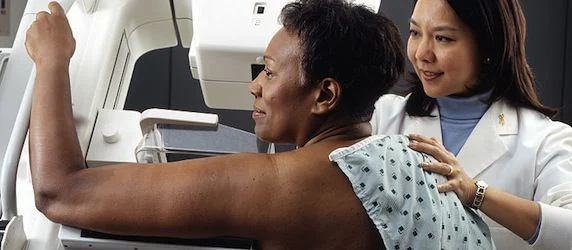Computer-assisted detection enhanced mammography finds more noninvasive and early-stage invasive breast cancer but also makes increases diagnostic testing for women without breast cancer, researchers from UC Davis and the University of Washington have found.
Using computer-aided detection (CAD) to assess mammograms increases diagnosis of early stage cancers, but also .
A new study shows that CAD helps detect some cases of DCIS and early-stage invasive breast cancer better than mammography alone. However, it also increases unnecessary additional evaluations.
Published in the April 16 issue of the Annals of Internal Medicine, the study of women enrolled in Medicare is the largest comparison of clinical outcomes of routine screening mammography with and without computer-assisted detection (CAD) — software developed to enhance the detection of breast cancer during screening mammography.
CAD was most strongly associated in the study with higher incidence of ductal carcinoma in situ (DCIS), a non-invasive breast lesion typically referred to as “stage 0” because it does not affect surrounding tissue or mortality.
“DCIS progresses slowly, if at all,” said lead author Joshua Fenton, an associate professor of family and community medicine at UC Davis. “Some of these early noninvasive lesions may never have come to clinical attention in women’s lifetimes if CAD were not applied to their mammograms.”
CAD was also associated with slightly higher rates of early-stage invasive breast cancer detection.
“There may be benefits if CAD detects early-stage invasive cancer before it progresses,” said Fenton. “A longer-term study would be needed to see whether fewer women die of breast cancer on account of the technology.”
The study also showed that CAD mammography was associated with increased diagnostic testing, including breast biopsy, among women who did not have breast cancer.
“This means that CAD increases the chances of being unnecessarily called back for further imaging or tests because of a false alarm, which is already a major problem without CAD,” said study co-author Joann Elmore, a professor of internal medicine and epidemiology at the University of Washington.
CAD algorithms assist radiologists by marking areas on mammograms that could be associated with breast cancer. Application of CAD has increased rapidly since being approved for Medicare reimbursement in 2001, and it is now used on approximately three out of every four screening mammograms in the U.S. The annual direct costs to Medicare are estimated by Fenton based on CAD prevalence and Medicare reimbursement and enrollment data to exceed $100 million each year.
For the study, Fenton, Elmore and their colleagues analysed Medicare claims data that were linked with a National Cancer Institute database of cancer diagnoses, treatments and survival. More than 163,000 women nationwide who were 67 to 89 years old when they underwent mammography with or without CAD during 2001 to 2006 were included in the study. The participants received more than 409,000 mammograms — an average of 2.4 mammograms per person — during the six-year period.
Compared to women screened without CAD, women screened with CAD had a 17 percent increase in diagnoses of noninvasive DCIS breast lesions and a 6 percent increase in diagnoses of early-stage invasive breast cancer. Among women who did not have breast cancer after all, there was a 19 percent increase in additional diagnostic imaging after screening and a 10 percent increase in breast biopsies.
Fenton and Elmore hope their findings also emphasize the need for research to distinguish early-stage breast cancers that are likely to progress from those that are likely to follow a benign course.
“CAD is expensive technology that has been nearly universally adopted in the U.S. due to Medicare’s support and the hope that it can help us identify and treat invasive breast cancer early,” said Fenton. “Our study suggests that we still don’t know whether the benefits outweigh the harms for the average woman on Medicare.”
Reference:
Short-Term Outcomes of Screening Mammography Using Computer-Aided Detection: A Population-Based Study of Medicare Enrollees. Joshua J. Fenton, Guibo Xing,Joann G. Elmore, Heejung Bang, Steven L. Chen, Karen K. Lindfors, Laura-Mae Baldwin. Ann Intern Med. 16 April 2013;158(8):580-587.
Latest Articles
Mammography, Computers
Computer-assisted detection enhanced mammography finds more noninvasive and early-stage invasive breast cancer but also makes increases diagnostic testing...










